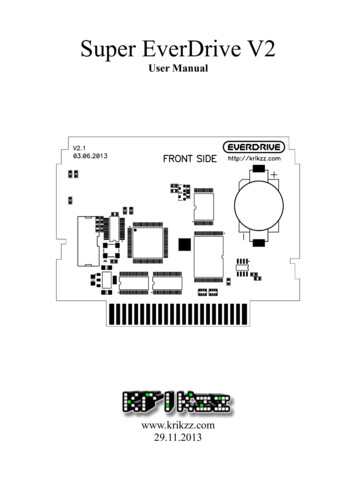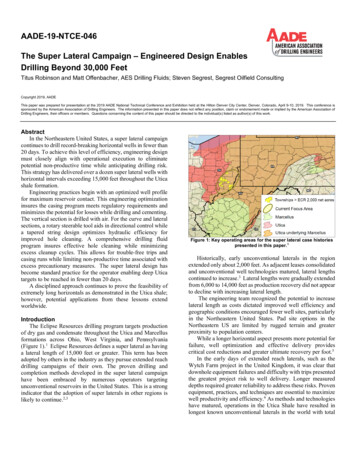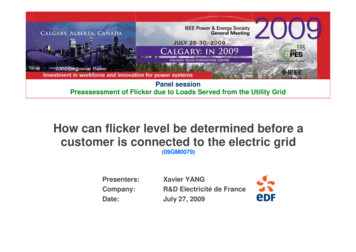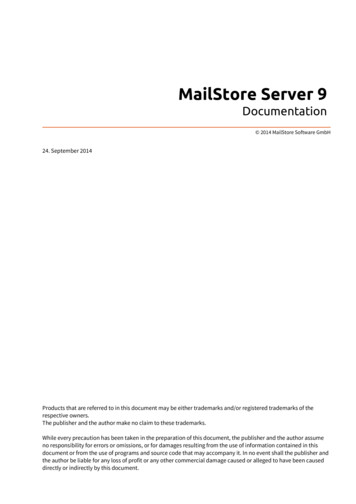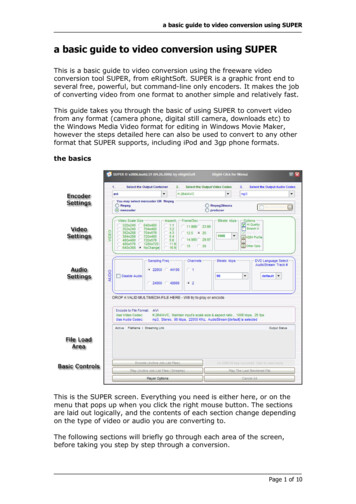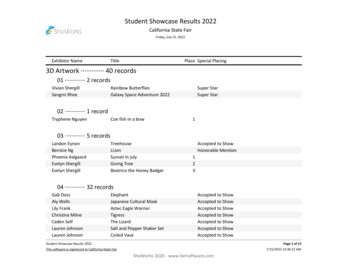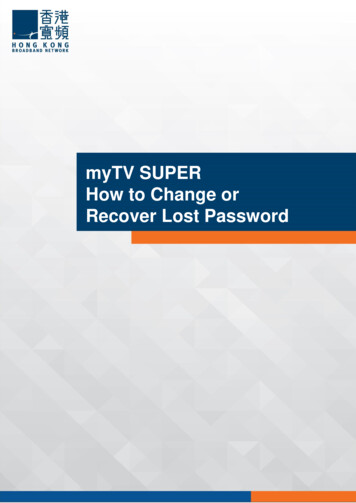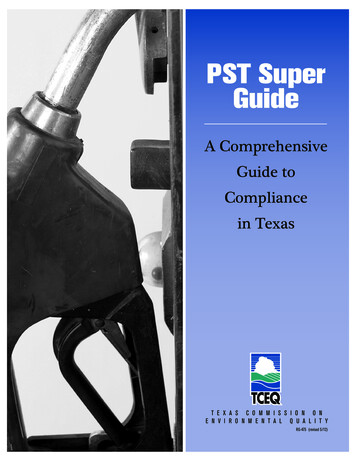
Transcription
PST SuperGuideA ComprehensiveGuide toCompliancein TexasT E X A S C O M M I S S I O N O NE N V I R O N M E N T A L Q U A L I T YRG-475 (revised 5/12)
PST SuperGuideA ComprehensiveGuide toCompliancein TexasT E X A S C O M M I S S I O N O NE N V I R O N M E N T A L Q U A L I T YRG-475 (revised 5/12)
ContentsRG-475a Buying or Selling Property with Underground Storage TanksRG-475b Installing a New or Replacement Underground Storage TankRG-475c Licensed Underground Storage Tank ContractorsRG-475d Petroleum Storage Tank Registration and Self-CertificationRG-475e Petroleum Storage Tank Spill and Overfill PreventionRG-475fProtecting Petroleum Storage Tanks against CorrosionRG-475g Petroleum Storage Tank Release Detection and Inventory ControlRG-475h Suspected Releases from Petroleum Storage TanksRG-475iFinancial Assurance for Petroleum Storage TanksRG-475jGasoline Stage I and II Vapor RecoveryRG-475k Who Regulates Petroleum Storage Tanks?RG-475lTemporarily Removing Petroleum Storage Tanks from ServiceRG-475m Permanently Removing Petroleum Storage Tanks from ServiceRG-475n Aboveground Petroleum Storage TanksRG-475o Training for Underground Storage Tank Operators
TCEQ REGULATORY GUIDANCESmall Business and Environmental Assistance DivisionRG-475aFebruary 2011Buying or Selling Property withUnderground Storage Tanks0BA guide for owners and operators of USTsThis is a general guide to laws and regulations about underground storage tanks andan aid in minimizing potential risks; it does not replace those laws and regulations,which take precedence over any information contained herein. If your tank system islocated in Kinney, Uvalde, Medina, Bexar, Comal, Hays, Travis, or Williamson County,additional requirements related to the protection of the Edwards or the TrinityAquifer may apply (Title 30, Texas Administrative Code [30 TAC], Chapters 213 and214). In addition to the laws and TCEQ rules, local governments and other state andfederal agencies may have rules that apply. The UST owner and operator areresponsible for ensuring compliance with all applicable laws and regulations.What should I do before I buy a gas station or a propertywith existing underground petroleum storage tanks?1BBefore making a purchase, you should determine two major issues:1. Are all UST systems in compliance with all technical requirements?2. Is there contamination on the property (either from one or more USTsystems or from other sources, including historical or off-site sources)?Keep in mind that you need as much information as possible from the previousowner to ensure technical compliance with applicable TCEQ rules. Installationrecords and documentation of compliance are invaluable and should besecured if at all possible. You may wish to secure estimates of cost to removetanks, search for historical information on them, and ask the former ownerfor records of their installation, removal, upgrades, release detection, andcorrosion protection, and other important documents related to theirperformance and maintenance. Ensure that any claims made by the seller canbe verified with installation, removal, and compliance records. If those recordsare not available, you should consider spending what is necessary to createthem. An environmental site assessment called a Phase I assessment iscommonly conducted prior to a transfer of ownership of commercial propertyto identify potential environmental contamination. Additionally, a Phase IIassessment is conducted to determine if there is contamination at the site.A Phase II assessment includes soil and groundwater samples.TEXAS COMMISSION ON ENVIRONMENTAL QUALITY PO BOX 13087 AUSTIN, TX 78711-3087T he T CEQ i s an equal opport unit y em pl oyer. T he agency does not al l ow di scrimi nat i on on t he basi s of race, col or, reli gi on, nati onal ori gi n, sex,di sabilit y, age, sex ual ori ent ati on, or v eteran st at us. I n compli ance wi t h t he Am ericans wi t h Di sabiliti es Act, t hi s docum ent m ay be request ed i nal t ernat e f ormat s by cont act i ng t he T CEQ at 512- 239- 0028, f ax 512-239- 4488, or 1-800- RELAY-T X (T DD), or by writi ng PO Box 13087, Austi n T X78711- 3087. W e aut hori ze you t o use or reproduce any ori gi nal mat eri al cont ai ned i n t hi s publi cati on — t hat i s, any m at eri al we di d not obt ai n f romot her sources. Pl ease acknowl edge t he TCEQ as your source. Pri nt ed on recycl ed paper.
Buying or Selling Property with Underground Storage TanksTCEQ publication RG-475aUnderground storage tanks may have previously been installed and registeredat the property and since removed or placed permanently out of service. If thetanks have been permanently removed from service, you should request acopy of the Release Determination Report (form TCEQ-00621) or other reportdocumenting the removal of the tank system and any confirmatory samplingthat may have been conducted. It is essential for a prospective property ownerto determine whether the TCEQ has issued a “no further action” letter to aprevious owner, indicating that removal of such a UST from service has beenconcluded with agency concurrence that no further action is needed by thecurrent owner. If no such letter has been issued, that means the agency has notgiven its final response to the permanent removal from service of the UST.How can I obtain information about the undergroundstorage tanks from the TCEQ?2B The Petroleum Storage Tank Registration Database can tell you whether afacility is registered with the TCEQ and gives technical information aboutregistered PSTs. www.tceq.texas.gov/goto/pst reg db H HThe Leaking Petroleum Storage Tank Database Query page can help you findcurrent and historic information about known LPST sites. Look upinformation by owner, address, city, county, and other criteria. www.tceq.texas.gov/goto/lpst db query H HThe Compliance History Database. State rules require the TCEQ to maintainand publish compliance histories for many of the companies, individuals,agencies, and other entities that it regulates. Histories become a rating of acustomer’s “distance from compliance.” Poor ratings can cause denial ofpermits, stricter regulation, and higher penalties. It’s important toremember that a buyer inherits the compliance history rating of the facility. www11.tceq.texas.gov/oce/ch/ H HCheck to see if there is a pending enforcement action against the currentowner of the UST system on the property. The status of any pending orissued enforcement order is available at: www.tceq.texas.gov/goto/pending enforcement H HYou may also perform an open-records request online, or via e-mail, fax, ormail to obtain documents, pending applications, ongoing compliance orenforcement actions, or other records. www.tceq.texas.gov/goto/records request HHFor additional current and historical registration information, you maycontact the PST Registration Team at 512-239-2160. For additional information on cleanup requirements or USTtechnical requirements, you may contact the Remediation Division at 512239-2200. 2February 2011
TCEQ publication RG-475aBuying or Selling Property with Underground Storage TanksWhat must I consider if there is contamination?3BThe TCEQ does not prevent the sale of LPST sites. All parties involved in thesale of property with an LPST should be aware of the cleanup requirementsand potential costs. Although the TCEQ continues to hold a responsible partyresponsible for a cleanup even after property is sold (i.e., a party may notcontract away environment liability once a release has been discovered),buyers are cautioned that they may also become responsible for performingany corrective action on their property. Parties may choose to minimize delaysin real estate transactions if, rather than insisting on the final closure of theLPST site by the TCEQ prior to the property sale, they instead address thisissue in the negotiated price or establish responsibility via contract, letter ofcredit, bond, or insurance. However, the TCEQ will not be bound by anyagreement between the parties.All interested parties should consider hiring a qualified environmentalconsultant and possibly an attorney to evaluate existing information.For a list of environmental consultants registered with the TCEQ, visit www5.tceq.texas.gov/oce/olwe or contact the Operator Licensing Sectionat 512-239-6139.What are my options regarding existing UST systems?4BIf underground storage tanks remain in the ground, they are generallyconsidered part of the property and are transferred with it, unless the sellerspecifically maintains ownership of them. The buyer is responsible for keeping(or making) the tanks compliant with applicable rules.All UST systems must be maintained in compliance with applicable TCEQrules, whether or not they are in use. If you are going to continue to use a USTsystem, it must comply with all technical and administrative requirements,including release detection, corrosion protection, spill- and overfill-preventionequipment, financial assurance, registration and self-certification, andrecordkeeping (and any other requirements that apply). Request, fromthe seller, all existing records associated with the UST system, includinginstallation documentation, owner’s manuals, and compliance documentation.If those records are not available, you may be required to re-create them orperform additional tests and actions to keep the UST system in compliance.If you are not going to use a UST system, one option for temporary removalfrom service is described at 30 TAC 334.54, and three options for permanentremoval from service (along with additional information) are described at30 TAC 334.55. Those three options are:1. removal from the ground,2. abandonment in place (proper emptying by a licensed UST contractor andfilling with sand, cement, etc.), orFebruary 20113
Buying or Selling Property with Underground Storage TanksTCEQ publication RG-475a3. permanent change in service (storage of non-regulated substances).Regardless of the option you choose, the work will need to be performed bya TCEQ-licensed UST contractor, and a comprehensive site assessment mustbe performed to determine whether a release has occurred from any part ofthe UST systems. For more information on permanent removal from service,see Permanently Removing Petroleum Storage Tanks from Service, TCEQpublication RG-475m.It is a good business practice to secure bids on actions to ensure the tanks’compliance (removal, upgrades, soil samples to determine if contamination ispresent) before taking ownership of the property. There is no substitutefor soil and groundwater sampling to determine if there is subsurfacecontamination.What Do I Need to Report?5BResponsibilities of sellers and purchasers of underground storage tanksWritten disclosurethat the tank isregulated by theTCEQ before theproperty istransferred to thepurchaserSellerPurchaserUpdate of formlisting tank statusand ownershipregistrationwithin 30 days ofsale (FormTCEQ-00724)Constructionnotification toTCEQ 30 daysprior to majorconstructionactivities (FormTCEQ-00495)Recordkeeping inaccordancewith 30 TAC334.10XXXXUnder 30 TAC 334.9, written notification from the seller to the buyer mustinclude the names and addresses of the seller (or grantor) and the purchaser(or grantee), the number of tanks involved, a description of each tank(capacity, tank material, and product stored, if applicable), and the agency'sdesignated facility identification number (if the entire facility is beingconveyed). The following certification statement is sufficient:The underground storage tank (or tanks) included in this conveyance is (are) presumed to beregulated by the Texas Commission on Environmental Quality and may be subject to certainrequirements for registration, compliance self-certification, and construction notification, andother requirements found in Title 30, Texas Administrative Code, Chapter 334.For further information regarding tank registration, refer to PetroleumStorage Tank Registration and Self Certification, TCEQ publication RG-475d.Where do I find more information?6BLaws and regulations pertaining to the PST program are found in Texas WaterCode, Chapter 26, Subchapter I, and at 30 TAC 334.4February 2011
TCEQ publication RG-475aBuying or Selling Property with Underground Storage TanksThe complete UST technical standards may be found at 30 TAC 334,Subchapter C.Guidance for conducting assessment and corrective action at leaking UST sitesis available in Investigating and Reporting Releases from Petroleum StorageTanks (TCEQ publication no. RG-411).Search for TCEQ publications online at www.tceq.texas.gov/publications .HHFor confidential environmental compliance assistance for small businessesand local governments, contact Small Business and Local GovernmentAssistance via the hotline at 800-447-2827 or online at www.TexasEnviroHelp.org .Definitions7BCorrective action. Any assessment, monitoring, or remedial activityundertaken to investigate the extent of contamination or to remediate it.Major construction activities. Includes removal of a tank from service; repairsto a tank, piping, or other parts of a tank system; and most other constructionassociated with tank systems.February 20115
TCEQ REGULATORY GUIDANCESmall Business and Environmental Assistance DivisionRG-475b Revised March 2011Installing a New or ReplacementUnderground Storage TankA guide for owners and operators of USTsThis is a general guide to laws and regulations about underground storage tanks andan aid in minimizing potential risks; it does not replace those laws and regulations,which take precedence over any information contained herein. If your tank system islocated in Kinney, Uvalde, Medina, Bexar, Comal, Hays, Travis, or Williamson County,additional requirements related to the protection of the Edwards or the TrinityAquifer may apply (Title 30, Texas Administrative Code [30 TAC], Chapters 213and 214). Besides the TCEQ, local governments and other state and federal agenciesmay have rules that apply. The owner and operator are responsible for ensuringcompliance with all applicable regulations.What are the requirements?A licensed UST installer–on-site supervisor employed by a registered USTContractor is required for installation of UST systems. Generally, a registeredcontractor will know the details of how to comply with TCEQ standards;however, compliance is ultimately the owner’s responsibility. It is helpfulfor the owner to know the basic requirements and to become familiar withterminology and options.Specific standards for equipment and installation procedures may be foundin 30 TAC 334 and, in some instances, petroleum-industry references andrecommended practices. In those cases, the most recent version of therecommended practice is in effect. For more information on licensingrequirements, please refer to module RG-475c, Licensed UndergroundStorage Tank Contractors.Submit a construction notification form to the TCEQ (form TCEQ-00495) atleast 30 days prior to performing work. Between 24 and 72 hours before workon the proposed activity begins, the owner must verbally notify the agency’sappropriate regional office. Many times the registered contractor gives notice,but it is ultimately the responsibility of the owner. Coordinate with yourcontractor to determine who will make the notification.New tanks and piping must meet specific standards for structural integrityand protection from corrosion. For example, a steel tank must have afiberglass or polyurethane coating, bond, or jacket that meets specificstandards. Additionally, all tank systems must be installed with appropriatespill- and overfill-prevention equipment and be monitored for releases.TEXAS COMMISSION ON ENVIRONMENTAL QUALITY PO BOX 13087 AUSTIN, TX 78711-3087T he T CEQ i s an equal opport unit y em pl oyer. T he agency does not al l ow di scrimi nat i on on t he basi s of race, col or, reli gi on, nati onal ori gi n, sex,di sabilit y, age, sex ual ori ent ati on, or v eteran st at us. I n compli ance wi t h t he Am ericans wi t h Di sabiliti es Act, t hi s docum ent m ay be request ed i nal t ernat e f ormat s by cont act i ng t he T CEQ at 512- 239- 0028, f ax 512-239- 4488, or 1-800- RELAY-T X (T DD), or by writi ng PO Box 13087, Austi n T X78711- 3087. W e aut hori ze you t o use or reproduce any ori gi nal mat eri al cont ai ned i n t hi s publi cati on — t hat i s, any m at eri al we di d not obt ai n f romot her sources. Pl ease acknowl edge t he TCEQ as your source. Pri nt ed on recycl ed paper.
Installing a New or Replacement Underground Storage TankTCEQ publication RG-475bNew UST systems must be installed to meet requirements for spill,overfill, and release detection, and must have striker plates under allfill and gauge openings.Tanks may be constructed of coated and cathodically protected steel; steelwith an external factory-applied, fiberglass-reinforced plastic; steel with apolyurethane cladding or jacket; or fiberglass-reinforced plastic.Piping may be constructed of fiberglass-reinforced plastic, coated andcathodically protected steel, or flexible non-metallic material. Flexibleconnectors must be installed at both ends of a pressurized piping systemunless the piping is inherently flexible. For pressurized piping systems,shear or emergency-shutoff valves must be properly installed and anchored.Tanks, piping, and shear valves must be constructed in accordance withapplicable standards.An appropriate number of observation wells 4 inches in diameter or largermust be installed in each tank hole. A tank hole containing only one tank isrequired to contain at least one observation well; a tank hole containing twoor more tanks must contain at least two wells.The installer must use clean, washed, suitably graded and noncorrosive sand,crushed rock, or pea-gravel backfill that is selected and placed in accordancewith the tank and piping manufacturers’ specifications.To prevent flotation of the tanks, an anchoring system is required for all USTslocated in areas subject to high water tables or flooding. The anchoring systemmust meet the tank manufacturer’s specifications and applicable TCEQrequirements.The piping system must slope at least 1/8 inch per foot from the dispensertoward the tank.Prior to initial use, the tanks and piping must be tested to ensure that there areno leaks in the system.Registration is required within 30 days of the initial delivery of any regulatedsubstance. Use form TCEQ-00724. Any tank-installation or undergroundinstallation activities must also be certified on that form by the responsibleUST installer or on-site supervisor. Factors to consider when installing a USTsystem include:the cost of insurance for the type of system installed the geographic location of the tank system release-detection optionsFor UST systems installed after Jan. 1, 2009Owners and operators must install secondary containment for new andreplacement tanks and new piping. Any piping replacement that affects20 percent or less of the total original length of an existing single-wall lineRevised March 20112
Installing a New or Replacement Underground Storage TankTCEQ publication RG-475bdoes not require secondary containment unless the replaced line segmentconnects the existing line to a new dispenser, in which case the entire linemust be secondarily contained. External liners do not meet secondarycontainment requirements for systems installed after Jan. 1, 2009. Owners andoperators must also monitor the interstitial space (the space between theprimary and secondary wall) for a release of product.Owners and operators must install dispenser sumps with any new dispenser.All sumps and manways used as an integral part of a UST release detectionsystem and all sumps which serve new dispensers installed on or after Jan. 1,2009, must be: compatible with the stored substance; installed and maintained in a manner that assures that sides, bottoms, andpenetration points are liquid tight;tightness-tested at installation and every three years thereafter; and equipped with a liquid-sensing probe that will alert the UST systemowner or operator if more than 2 inches of liquid collects in any sumpor manway.Owners and operators must properly dispose of any liquid detected byalarms or any liquids or debris found during an inspection within 72 hoursof discovery. For UST systems installed over the Edwards orTrinity AquiferIf your UST system is being installed over the Edwards or Trinity Aquifer,specific requirements apply that may be found in 30 TAC 213 and 214,respectively.What records do I need to keep?You must retain documentation of installations, certifications, notifications,reports, inspections, registration, as-built plans, specifications, revisions,modifications, integrity assessment, components, warranties, instructions,recommendations, schedules, and telephone numbers of contacts and servicetechnicians for the life of the system. Certain other equipment records,including records of air and tightness tests, must be kept for at least fiveyears after installation.Where can I find more information?The requirements for new technical and installation standards are at30 TAC 334.45–46.You can download forms from the TCEQ’s website at www.tceq.texas.gov/forms .Revised March 20113
Installing a New or Replacement Underground Storage TankTCEQ publication RG-475bYou can download publications from the TCEQ’s website at www.tceq.texas.gov/publications .For confidential environmental compliance assistance for small businessesand local governments, contact Small Business and Local GovernmentAssistance via the hotline at 800-447-2827 or online at www.TexasEnviroHelp.org .Industry Recommended PracticesPetroleum Equipment Institute Publication RP-100, Recommended Practicesfor Installation of Underground Liquid Storage Systems. www.pei.org/ American Petroleum Institute Publication 1615, Installation of UndergroundPetroleum Storage Systems. www.api.org/ Revised March 20114
TCEQ REGULATORY GUIDANCESmall Business and Environmental Assistance DivisionRG-475c March 2011Licensed Underground Storage TankContractorsSelecting the proper contractor to work on yourUST systemThis is a general guide to laws and regulations about underground and abovegroundstorage tanks and an aid in minimizing potential risks; it does not replace those lawsand regulations, which take precedence over any information contained herein. Ifyour tank system is located in Kinney, Uvalde, Medina, Bexar, Comal, Hays, Travis, orWilliamson County, additional requirements related to the protection of the Edwardsor the Trinity Aquifer may apply (Title 30, Texas Administrative Code [30 TAC],Chapters 213 and 214). In addition to the laws and TCEQ rules, local governmentsand other state and federal agencies may have rules that apply. The ownerand operator are responsible for ensuring compliance with all applicable lawsand regulations.Who Should I Hire?The TCEQ regulates occupational licenses and registrations with regardto underground storage tanks. It is important that you contract with theappropriate company or person to perform any necessary work. See 30 TAC30 (Occupational Licenses and Registrations), Subchapters E (LeakingPetroleum Storage Tank Corrective Action Project Managers and Specialists)and I (Underground Storage Tank On-Site Supervisor Licensing and ContractorRegistration).Why do I need a Licensed Contractor?Licensing and registration requirements exist because working on aUST system requires detailed technical knowledge. Be sure to check theexpiration date on the contractor’s license and ask for proof of liabilityinsurance before allowing work to begin on your UST system. This guideshould help you to determine when to use a licensed person to perform workon your UST system.DefinitionsUnderground storage tank contractor. A person (business or individual) thatinstalls, repairs, or removes a UST (or offers to, or self-represents as able to,do so) and meets registration requirements.On-site supervisor. An individual who supervises the installation, repair, orremoval of a UST and who meets licensing requirements. There are threelevels of licensing, each with its own responsibilities.TEXAS COMMISSION ON ENVIRONMENTAL QUALITY PO BOX 13087 AUSTIN, TX 78711-3087T he T CEQ i s an equal opport unit y em pl oyer. T he agency does not al l ow di scrimi nat i on on t he basi s of race, col or, reli gi on, nati onal ori gi n, sex,di sabilit y, age, sex ual ori ent ati on, or v eteran st at us. I n compli ance wi t h t he Am ericans wi t h Di sabiliti es Act, t hi s docum ent m ay be request ed i nal t ernat e f ormat s by cont act i ng t he T CEQ at 512- 239- 0028, f ax 512-239- 4488, or 1- 800- RELAY-T X (T DD), or by writi ng PO Box 13087, Austi n T X78711- 3087. W e aut hori ze you t o use or reproduce any ori gi nal mat eri al cont ai ned i n t hi s publi cati on — t hat i s, any m at eri al we di d not obt ai n f romot her sources. Pl ease acknowl edge t he TCEQ as your source. Pri nt ed on recycl ed paper.
Licensed Underground Storage Tank ContractorsTCEQ publication RG-475cCritical juncture. Any of the following steps:repairing the tank bedding immediately before receiving a tank setting a tank and its piping, including placement of anchoring devices,backfilling to the level of the tank, and strapping connecting piping systems to a tank pressure testing a UST and its associated piping during installation completing backfill and filling the excavation any repair involving connection (or reconnection) of a piping system to atank and related testing of the tank or its associated piping removal of the UST Corrosion specialist. An individual who has a professional degree and relatedexperience, and is certified by the National Association of Corrosion EngineersInternational or is licensed as a professional engineer in Texas in a branch ofengineering that includes education and experience in corrosion control ofmetal tanks and piping.Corrosion technician. A person who is qualified by training and experience andwho is certified by the National Association of Corrosion EngineersInternational, employed under the direct supervision of a corrosion specialist,or certified as a cathodic-protection tester by the NACE or the Steel TankInstitute.Corrective action. Any cleanup of contamination, or assessment (afterdiscovery), monitoring, or investigation of its extent.LPST Corrective Action Specialist (CAS). A company registered with the TCEQto perform regulated corrective actions at LPST sites that has two years ofexperience.LPST Corrective Action Project Manager (CAPM). A person who is licensed withthe TCEQ to perform or supervise regulated corrective actions at leakingpetroleum storage tank sites.Contractors for Leaking Petroleum Storage TanksOnce a leak is confirmed, an LPST contractor is needed to perform regulatedcorrective actions on the underground storage tanks. A corrective actionspecialist must be registered with the TCEQ in order to perform correctiveactions at an LPST site. In general, a corrective action project manager isrequired to be on the LPST site while work is conducted there. RegisteredLPST corrective action specialists are required to maintain at least 1 millionof liability insurance. For more information, reference module RG-475h,Suspected Releases from Petroleum Storage Tanks.Table 1 indicates which licensees can perform various tasks related to aUST system.2March 2011
TCEQ publication RG-475cLicensed Underground Storage Tank ContractorsTable 1. UST license levels and work the license holders can perform.UST Contractor LicenseOn-SiteSupervisor AUST InstallationXXRepair (upgradesand replacements)XXRemoval On-SiteSupervisor BOn-SiteSupervisorClass ianXDesign of corrosionprotection systemXCorrosion testingXPressure testing(during installationand repair)XSecondarycontainmentXXInstallation orreplacement of ventlinesXXInstallation orreplacement ofsubmersible pumpsXXInstallation ofequipment to testtightness of tank orpipingXXInstalling permanentrelease detectionand monitoringequipmentXXAdding or replacingspill or overfillequipmentXXInstallation of stage Ior stage II equipmentXXXA registered UST contractor is required to maintain 1 million liability insurance.A UST contractor must have a supervisor on-site at all times during critical junctures ofinstallation, repair or removal.A UST contractor must prominently display his or her registration number on all bids,proposals, offers, and installation drawings.March 20113
Licensed Underground Storage Tank ContractorsTCEQ publication RG-475cExceptions from LicensingThe following activities do not require using licensed companies orindividuals:emergency actions to stop leaks or ruptures work on a UST system under the direct supervision of a licensed on-sitesupervisor work on a system that is not regulated under 30 TAC 334 Where do I find more information?TCEQ Rules—30 TAC 30, Subchapters E and I: http://info.sos.state.tx.us/pls/pub/readtac ext.ViewTAC?tac view 5&ti 30&pt 1&ch 30&sch E&rl Y http://info.sos.state.tx.us/pls/pub/readtac ext.ViewTAC?tac view 5&ti 30&pt 1&ch 30&sch I&rl Y Complete online list of licensed contractors: www5.tceq.texas.gov/oce/olwe/ About field citations: www.tceq.texas.gov/goto/field citation Sample field citation: www.tceq.texas.gov/assets/public/compliance/field ops/citation/20270pst-web-version.pdf For confidential environmental compliance assistance for small businessesand local governments, contact Small Business and Local GovernmentAssistance via the hot line at 800-447-2827 or online at www.TexasEnviroHelp.org .4March 2011
TCEQ REGULATORY GUIDANCESmall Business and Environmental Assistance DivisionRG-475d April 2011Petroleum Storage Tank Registration andSelf-CertificationA guide for owners and operators of undergroundstorage tanks (USTs)This is a general guide to laws a
Buying or Selling Property with Underground Storage Tanks TCEQ publication RG-475a 4 February 2011 3. permanent change in service (storage of non-regulated substances). Regardless of the option you choose, the work will need to be performed by a TCEQ-licensed UST contractor, and a comprehensive site assessment must

